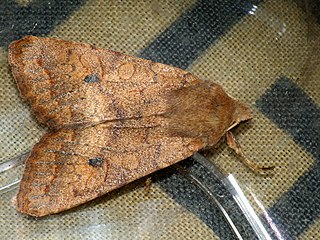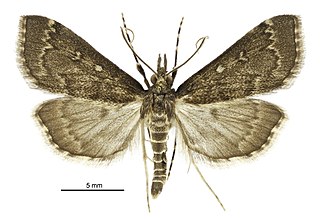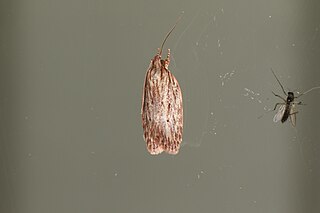
Agrochola circellaris, or The Brick, is a species of moth of the family Noctuidae. The species was first described by Johann Siegfried Hufnagel in 1766. It is distributed throughout most of Europe, Asia Minor and Armenia.

Cirrochroa thais, also known as the Tamil yeoman, is a species of nymphalid butterfly found in forested areas of tropical Sri Lanka and India. It is the state butterfly of the Indian state of Tamilnadu.

Hypena rostralis, the buttoned snout, is a moth of the family Erebidae. It is found in Europe far into Scandinavia.Then through the Palearctic into Asia Minor, the Caucasus and east to Siberia. It is widespread at forest edges, forest clearings, shore areas, in gardens, park landscapes and cultivated land and rises in the mountains up to 1600 m.

Proternia is a monotypic moth genus of the family Crambidae described by Edward Meyrick in 1884. Its only species, Proternia philocapna, described by the same author in the same year, is endemic to New Zealand.
Tanaobela is a genus of moths in the superfamily Pyraloidea containing only one species, Tanaobela chrysochlora, which is found in Australia, where it has been recorded from Queensland. Its affiliations are disputed.

Maliattha signifera is a species of moth of the family Noctuidae first described by Francis Walker in 1858. It is found in south-east Asia, including China, India, Japan, Taiwan, Korea and Thailand as well as in Australia (Queensland).
Surattha invectalis is a moth in the family Crambidae. It was described by Francis Walker in 1863. It is found in Sri Lanka, India, Java, Indonesia, Myanmar, and Kenya.
Prionapteryx scitulellus is a moth in the family Crambidae described by Francis Walker in 1866. It is found in India, Sri Lanka and Kenya.
Syllepte microspilalis is a moth in the family Crambidae. It was described by George Hampson in 1912. It is found in Singapore.
Syllepte ochrotozona is a moth in the family Crambidae. It was described by George Hampson in 1898. It is found in Australia, where it has been recorded from Queensland.
Syllepte phaeopleura is a moth in the family Crambidae. It is found in Australia, where it has been recorded from Queensland.
Syllepte phricosticha is a moth in the family Crambidae. It was described by Turner in 1908. It is found in Australia, where it has been recorded from Queensland.
Syllepte tenebrosalis is a moth in the family Crambidae. It is found in Australia, where it has been recorded from Queensland.
Syllepte trachelota is a moth in the family Crambidae described by Alfred Jefferis Turner in 1913. It is found in Australia, where it has been recorded from Queensland.
Voliba psammoessa is a moth in the family Crambidae. It was described by Turner in 1908. It is found in Australia, where it has been recorded from Queensland.
Garrha ochra is a moth in the family Oecophoridae. It was described by Turner in 1946. It is found in Australia, where it has been recorded from Western Australia.
Garrha acosmeta is a moth in the family Oecophoridae. It was described by Turner in 1896. It is found in Australia, where it has been recorded from Queensland.
Aeolanthes ampelurga is a moth in the family Depressariidae. It was described by Edward Meyrick in 1925. It is found in northern India (Kumaon).

Pedois ceramora is a moth in the family Depressariidae. It was described by Edward Meyrick in 1902. It is found in Australia, where it has been recorded from Victoria.
Chlamydastis epophrysta is a moth in the family Depressariidae. It was described by Edward Meyrick in 1909. It is found in Peru.





